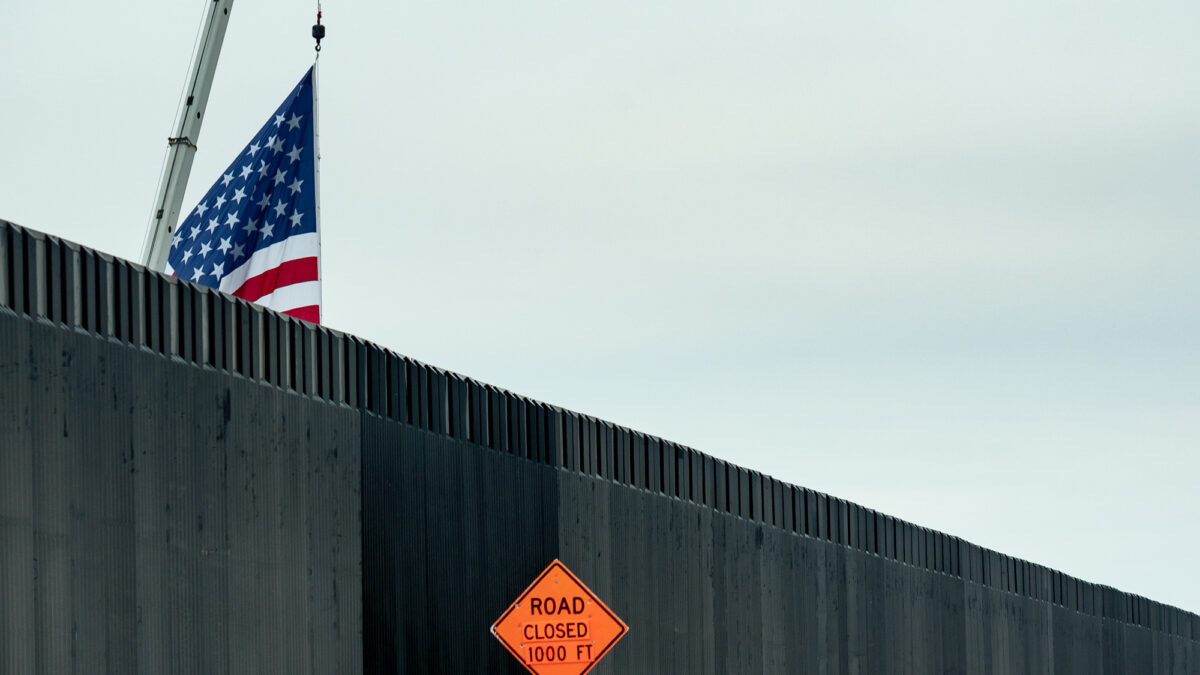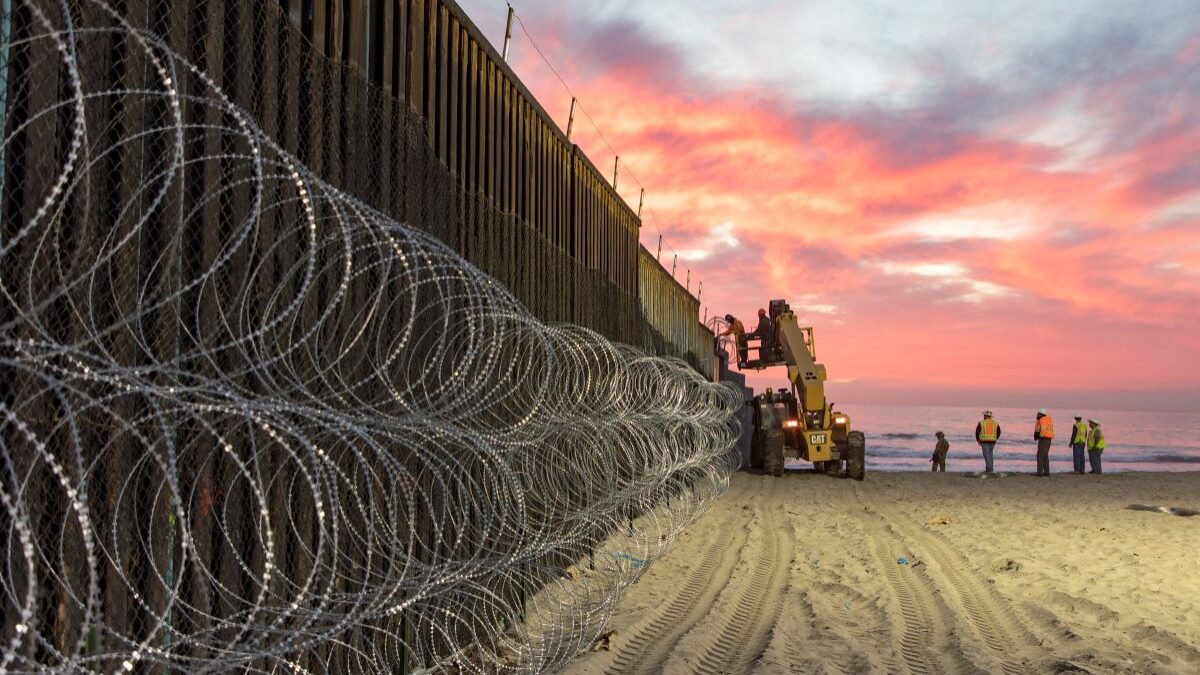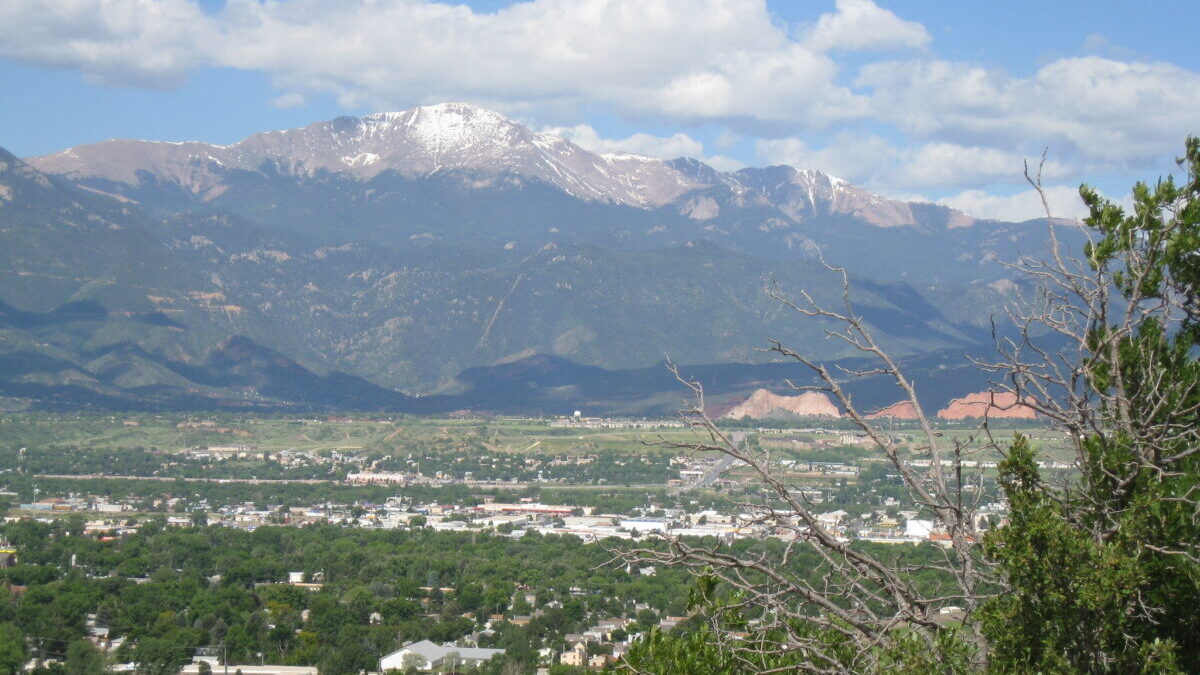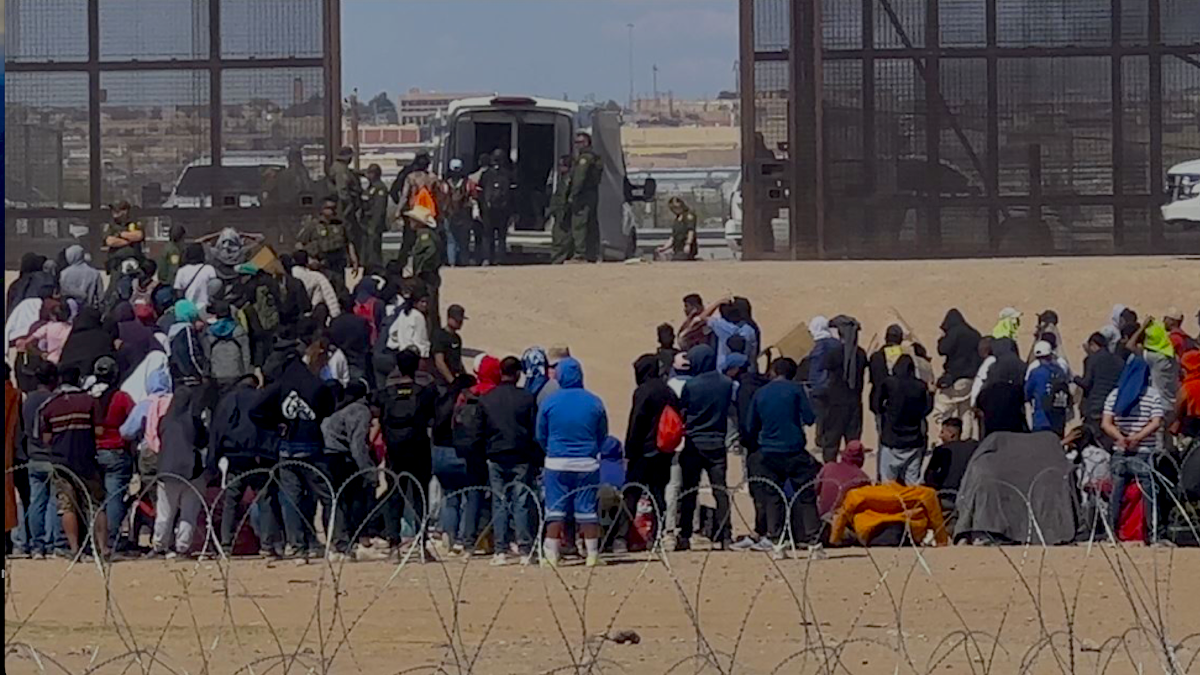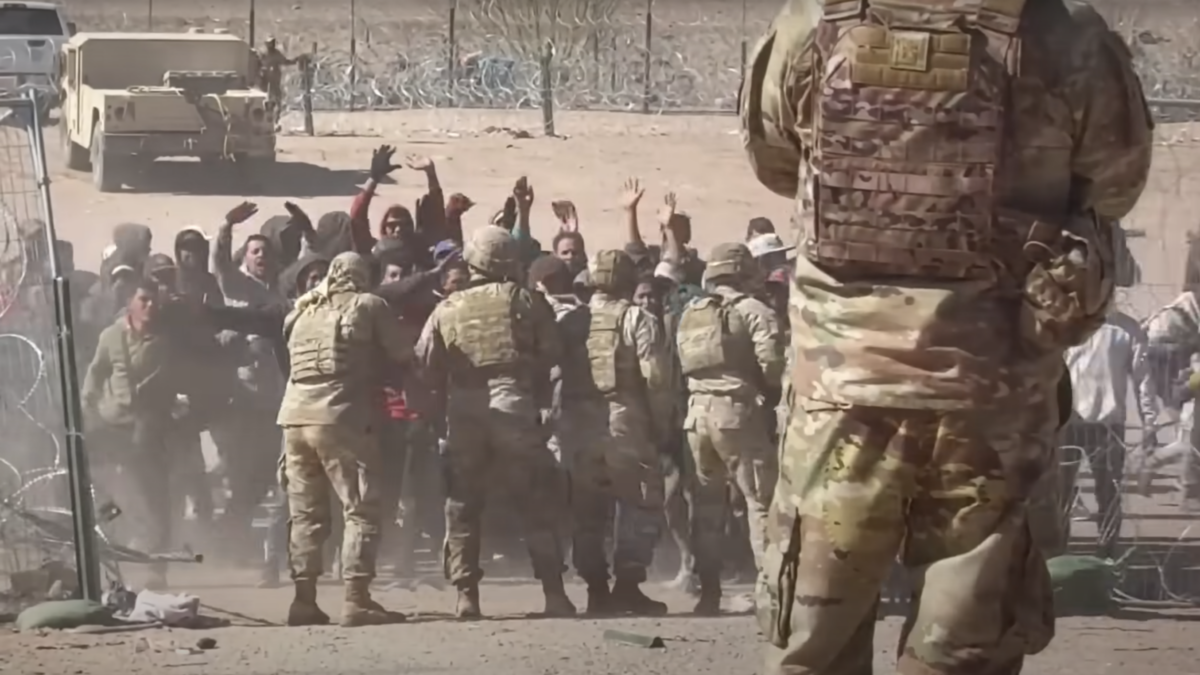This is an excerpt of “Overrun: How Joe Biden Unleashed the Greatest Border Crisis in U.S. History,” by Todd Bensman, out last month from Bombardier Books.
Biden set his work-freeze day for Jan. 27, 2021, a Wednesday. But after the November election, contractors ramped up work 24/7 to put up as much wall as possible before the inauguration, a literal race against time.
Curious to bear witness to the end of construction on that fateful morning, I set out in a rental truck west from El Paso on State Highway 9, which almost hugs the Mexican border only a half mile or a mile inside New Mexico. This was beautiful, if forbidding, high desert scrub brush country. Enormous brown vistas contrasted hard against blue sky. I’d always loved this stretch of border for its escarpments and burgeoning hills, which struck me as otherworldly, evocative of images delivered to us from the Mars exploration rovers.
The drive west along 9 provided a constant view of the long brown wall always on the left. The plan was easy: drive until I could see where the wall stopped and then go there and report whatever was happening. I was hoping to meet Border Patrol agents who worked the area before the wall went up and hear what they would have to contend with after the construction halt.
Listening to wall opponents and their arguments over time, I’d come to really appreciate Border Patrol agents as the most reliable experts on border security and especially the walls, since it is they who spend 40 hours a week every week for months and years working along them, mingling with immigrants and smugglers, and imbibing intelligence reporting.
I followed the wall on westward until its punctuated end came into view, a widened construction road gashing on past the final panel and up a steep hill and over. I turned due south down a dirt access road that emptied onto the east-west construction road right in the wall’s shadow and took a right alongside its towering panels. I was some 75 miles west from El Paso, some 30 miles west of the tiny historic New Mexican town of Columbus. The town was infamous as the site of a losing 1915 incursion by Mexican revolutionary and guerrilla Pancho Villa, the only time an armed foreign army invaded the U.S. and killed American citizens. American cavalry troops armed with new belt-fed machine guns drove Pancho Villa’s raiders away in a bloody battle.
An Anticlimactic End
For the last couple hundred yards, I passed giant, parked, yellow bulldozers, cranes, and trenching machines facing the other direction, lined up for evacuation. I parked at the wall’s final sputtering panel, which had gone up the night before. I got out, stretched, and sauntered over to it. An empty trench maybe 20 feet long and at least seven feet deep had been dug the day before where workers would pour concrete and then set the next panel. This stretch of wall was replacing an old 1990s-era vehicle barrier that ran up the etched distant hill and over. I easily hopped back and forth over it to check out the trench, careful not to fall in.
The death scene of Trump’s infamous border wall, one of America’s great political controversies, felt decidedly anticlimactic.
An evacuation of equipment and workers was underway, sure. There were no security guards, no public affairs officers, and no reporters. There were no news stories the next day or week. Hundreds of millions of dollars’ worth of paneling and equipment and contracts would lie fallow from this day on, with no cleanup plan.
But no one on either side of the partisan divide cared enough to mark the event or hold a field press conference where reporters might ask obvious questions like: What’s the government going to do with all these acres of paid-for steel paneling stacked in the desert? There were no gawkers other than me, and no one cared that I was roaming around open trenches, sharp-edged stacks of rebar, and heavy machinery. To my right, on a vast scraped acreage, work crews busied themselves amid more giant CAT machines and piles of wall panel, steel bollards, gear of unspecified purpose, and port-a-potties. I walked among them and climbed atop a pile of panels to shoot video.
The workers struck me as desultory, maybe a bit depressed, and who could blame them for having lost well-paying jobs? Occasionally, a driver would hop aboard one of the CAT earth-movers and fire it up. Beeping at intervals, these machines would trundle on their heavy tank-like treads over to the wall road and creak slowly eastward until they were out of sight. A poignant ending scene in a movie drama or children’s book, I thought, as I videoed a lonely trench digger slowly shrinking into the distance next to the wall it helped build that was no longer wanted.
Smugglers Avoid Walls
Ironically, none of the workers I asked to interview could speak English. None wanted to interview with me, anyway, sensing trouble talking to a notebook-toting stranger about a sensitive topic. One guy called someone to report that I was trying to interview him, but I stuck around hoping that whoever came might be willing to be interviewed. No one bothered.
Eventually, a Border Patrol agent rolled up to the final panel and stopped. I sauntered up for a chat at the window. He wasn’t happy about the construction stoppage. All the Democratic presidential candidates, including Biden and Harris, incorporated anti-wall policy and arguments prominently in their campaign platforms.
The argument was always that walls just don’t work to stop illegal immigration and drug trafficking, and taxpayer money should not be wasted on them. But this agent and a number of others I interviewed who work the wall described the same simple, inalterable physics about its impact on regular pedestrian immigrant flows.
Illegal immigrants and their smuggling guides avoid places where there are walls and go to where there are no walls.
Were there no gaps, maybe most people wouldn’t even bother. The agent said the plan was that this section of the wall would be built westward until it touched with another segment that was being built eastward, something like the transcontinental railroad, probably minus the golden spike ceremony.
The work stoppage had left a beckoning 1.5-mile gap of open ranchland between the two wall ends that he’d have to patrol now. The agent said he wished the gap was a lot shorter. Out here, a mile or two of desert crevices with lots of hills and dales is still a lot of land for one or two agents to patrol.
“What do you think about these experts who say walls are but a useless folly?” I asked.
“You hear TV, and they would say, ‘Well the experts say the wall isn’t effective,’ and I never understood who these experts were,” the agent responded. “Because all of our data says, you know, 90 percent effective rate … dropping of crossings … increased apprehensions and all of that. And it’s like, well who are these experts to say it wasn’t effective and what are they basing that on? You know, they never really specify.”
“Yeah, well what about the ladders, cutting tools, and rope-climbing they say entirely neutralize wall effectiveness?” I asked.
These tactics, he answered, only ever enable a few of the strongest, boldest, youngest physically fit Olympiads at a time to get over this 30-foot-high wall, he replied. Whereas before it was built, groups of 60 to 80 immigrants would routinely just climb over the chest-high vehicle barrier. That’s a big difference for Border Patrol.
“That was always a fallacy, that ‘well, they can dig under … they can climb over, or even have those gliders that come over,’ and it’s like, yeaaahhh nothing’s 100 percent,” he said. “It [a wall] was always something we wanted. It was always something we wanted more of. Every administration gave it to us. It was always proven effective.”
That last part was true. Dating back to the mid-1990s under President Clinton’s Operation Gatekeeper, 135 miles of pedestrian border wall went up mainly in the areas of El Paso and San Diego. The Secure Fence Act of 2006, signed by President George W. Bush (and voted for by then-Sens. Obama and Biden) provided for about 700 miles of fencing and vehicle barrier. Ultimately about 278 miles of 15 to 18-foot pedestrian wall and another 249 miles of the easily defeated “vehicle barriers” of the sort Trump’s 30-foot wall was replacing were constructed.
Obama kept the wall building going, putting up another 128 miles. It is true that drug trafficking cartels and human smugglers do beat the walls, especially in remote areas where the Border Patrol is thin or most agents were redeployed to South Texas to help process families the Biden administration had decided to admit. But this agent said Olympian drug smugglers are a tiny fractional minority of a wide cross-section of migrants who would come through if the wall weren’t there. The wall means Border Patrol agents have plenty of time to hunt down fewer smugglers with less effort, he said.
‘Let Them Lug a 45-Foot Ladder Out Here’
Later that day, in a parking lot at the international crossing port to the little Mexican town of Palomas across from Columbus, I asked another Border Patrol agent about the import of the construction halt.
“As much as people like to let their gums flap about things they don’t know about … a wall is a great deterrent,” he said. “That whole tall-wall-taller-ladder thing? Hahaha, fine, let them lug a 45-foot ladder out there in the middle of the desert. It’s a deterrent. A lot of people have no interest in risking their lives to climb that high or lug a band-saw and cutting tools out to the middle of nowhere.”
I know I’d never go 30 feet high up some teetering ladder, I told him, unless maybe I stood to make a ton of drug money taking that risk.
Some still take that risk, liberal media love to crow. But the reality is that their numbers are, in relative terms, minuscule. Statistics published in April 2022 by University of California at San Diego physicians in the journal JAMA Surgery tallied 375 falling injuries since the barrier’s height was raised along much of the California border in 2019, including 16 deaths.
Videos on social media show “athletic young men” breezily shimmying up and gripping the bollards like fire poles to zip down the other side, an April 2022 Washington Post story giddily reported, much later pointing out why these athletes are a tiny minority.
“But that type of skilled maneuver is beyond the abilities of many migrants…”
Most everyone else is heading for where there is no wall. The 375 injuries and deaths compare to more than 350,000 Border Patrol apprehensions in California since Trump’s wall went up in 2019.
Mind the Gaps
The Jan. 27, 2021, construction freeze left gaps everywhere, some just a few feet across, others many miles.
On a Texas Department of Public Safety helicopter tour of the wall in South Texas, I noticed miles of walling that resembled the jaw of a shark with every other tooth missing. The missing teeth did not draw in merely a few hundred young Olympiads like those climbing ladders, breaking legs or dying in falls. They sucked in hundreds of thousands of illegal immigrants, not to mention drug traffickers.
One emblematic gap attracted such an unending mass of humanity that Border Patrol has had to throw up its hands in surrender at times, unable even to process them. The spot was on the Yuma, Arizona, border with Mexico and became infamous as “the Yuma Gap.” From January 2021 through July 2022, more than 374,000 immigrants poured through a three-panel space and several others along a levee on the Colorado River near the Morelos Dam.
Almost unbelievably, the Biden administration let this torrent flow for a full year and a half, refusing to speak of it or visit it as Republican Arizona politicians and local law enforcement furiously complained. National media largely ignored this incredible drama until the Biden administration finally announced in July 2022 that it would close the four Yuma gaps. Eventually.
In the ensuing delay, Arizona Gov. Doug Ducey stepped in with old shipping containers and tightly packed them side-by-side in the gaps right at the dam. That seemed to do the trick, as a personal testament to their impacts demonstrates. In November 2022, I visited from the Mexican side with Mexican journalist Oscar “El Blue” Ramirez to see how things were going. We were the only ones anywhere in sight as we hiked gingerly through four inches of water along the bottom of the dam toward the shipping containers visible several hundred yards ahead.
Now, a single Border Patrol agent stood vigil up the embankment 50 yards ahead with plenty of time on his hands. I shouted up that I was an American, a writer, and, by the way, how busy was it these days now that those shipping containers behind him were in place? He said, not very busy at all any more. The agent threatened to arrest me for improper return outside an official port of entry, a crime that came with a $5,000 fine.
As we hiked back to Oscar’s blue jeep, two Mexican cops were waiting, saying the Border Patrol agent had called them in to get rid of us. All of this served as a testament to how Border Patrol is able to capably turn away human traffic when the numbers aren’t swamping them.
